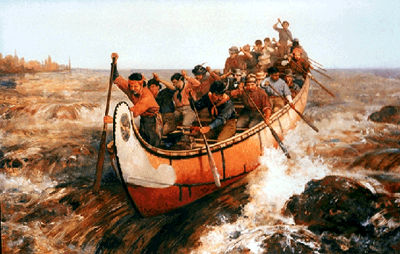Voyageurs
The cliché, woven red arrowhead sash evokes a vivid character of perilous adventure – les voyageurs. They were mainly hired by The North West company in the fur trade industry during the 17th and 18th centuries.[1] Voyageurs and coureurs des bois were synonymous in the 17th century; both were licensed traders responsible for the exchange of goods between suppliers to Indigenous peoples. While voyageurs remained contracted by merchants or military officers with permits, coureurs des bois did not have permits and were considered outlaws once the trading licence system was implemented in 1681.[2]
The voyageurs were young French men hired to transport goods to trading posts which later developed into a supervising role, a “canoe master”. Voyageurs ensured the engagés (hired workers) would transport goods from merchant-suppliers and return to Montreal with furs. “Merchant voyageurs” were contracted for three years by merchants and military officers with established trading companies. The fur trade shifted in the 19th century; the number of engagés increased drastically and the bourgeois (often Scottish immigrants) replaced the role of the voyageur.[1]
Although the jovial voyageur folksongs and tales of exploration are romantic, they endured extreme hardship. A typical day involved paddling from 14 to 16 hours, sleeping under canoes, enduring mosquitoes, flies, and harsh elements such as the bitter cold, blistering sun, and pouring rain. During a portage, they carried approximately 170 lbs upon their backs. Their survival depended on cheerful camaraderie and supporting one another.[3]
Voyageurs had a variety of clothing attire over the centuries rather than the stereotypical red or blue tuque, arrowhead sash, moccasins, and hood produced by our collective imagination. Singing during their hard labour produced a large repertoire of tuneful songs, such as “Alouette,” “Rame rame,” and “C’est l’aviron.” Annually, events such as the Festival du Voyageur (Manitoba) are presented to celebrate the voyageurs and French-Canadian culture through exquisite cuisine, lively dance, and festive music.[4]
Suggested Sources:
- Foster, John E. , and Suzanne Gousse. “Voyageurs.” The Canadian Encyclopedia. Historica Canada. Article published June 07, 2007; Last Edited November 07, 2019.
- Wien, Tom. “Coureurs des bois.” The Canadian Encyclopedia. Historica Canada. Article published February 06, 2006; Last Edited November 07, 2019.
- Government of Canada. “The voyageurs.” Accessed March 6, 2025. https://parks.canada.ca/lhn-nhs/qc/lachine/culture/histoire-history/site/voyageurs
- Festival du Voyageur. “Infos Générales.” Accessed March 6, 2025. https://heho.ca/festival/infos-generales/
Related Contents:
Rame, rame


